Live-Vibe Audio RP-1 Vibration Management by Moreno Mitchell
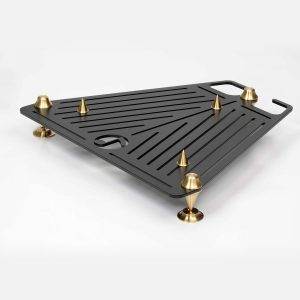
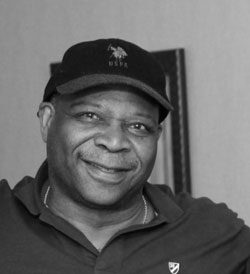 A Game Changer
A Game Changer
I honestly believe that the High-end audio hobby, journey, or whatever you want to call it has to be one of the most subjective, diverse, not to omit rewarding and sometimes frustrating hobbies I have ever participated in. I have indulged in many other hobbies. However, music and audio happen to be my passion. There are many examples I can speak on to validate this; however, I am sure many of you who are reading this review can relate.
This review is mainly about a recent discovery in effectively managing vibration and making it work to your systems’ advantage. When I moved up to what I thought were the best audio components I could afford, including amplifiers, speakers, and front-end/source components, I set up a synergy-based system that proved stellar in many ways. The signature sound of these components collectively provided me with complete satisfaction and a sense of audio nirvana.
But let’s be honest: We audiophiles are never completely satisfied. We sit and listen to our systems and wonder, “How can I make this better?” It doesn’t matter how good your system is. We have a sense of creativity about us that is very hard to suppress. In other words, those audio gremlins are in our heads, whispering, “How can I make this or that better?” Are we in need of an audio psych doctor?
This can be a very challenging aspect of the hobby; it can also be hazardous. I have had audio setups that sounded extremely good; however, once I got to tinkering, I would completely lose that signature sound and become no longer moved by the music as before. Yes, you can reverse engineer your steps; however, if one gets too deep, you take the danger of never returning to that signature sound.
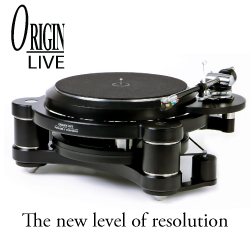 This is where I started with the Live-Vibe Audio products. My system was cooking, and I was convinced it was time to shut things down and leave well enough alone. My Thrax Spartacus 300B Monoblock amplifiers sat on top of Townshend speaker podiums, and my Y.G. Acoustic Sonja Speakers were spiked to the carpet. I felt the sound I was getting was first-class. The remainder of my front-end source components are placed on the top-of-the-line Stillpoints rack, which I am thrilled with.
This is where I started with the Live-Vibe Audio products. My system was cooking, and I was convinced it was time to shut things down and leave well enough alone. My Thrax Spartacus 300B Monoblock amplifiers sat on top of Townshend speaker podiums, and my Y.G. Acoustic Sonja Speakers were spiked to the carpet. I felt the sound I was getting was first-class. The remainder of my front-end source components are placed on the top-of-the-line Stillpoints rack, which I am thrilled with.
Ok, so why not leave well enough alone? Answer: because I am an audiophile, and nothing is ever left well enough. To be honest, what spurned my interest in writing this review was that I wanted to create more airflow for the amplifiers by raising them individually. Class A tube amplifiers create lots of heat and need circulating air for cooling. I set out to find a pair of stands to accommodate this; however, based on painstaking research, I ran across the concept of vibration management. Of all the articles, reviews, and white papers read, one stood out above the rest. Live-Vibe Audio wrote this.
 Live-Vibe Audio HISTORY
Live-Vibe Audio HISTORY
The formation of today’s Live Vibe Audio, LLC began in 1989 with the release of a conical-shaped product titled Audio Points™; in late 1999, a newer vibration management theorem was introduced, positioning the first vibrating equipment rack titled Sistrum Platforms™ as a first in audio. This innovation led to the discovery of a highly adaptable and scalable vibration management technology titled Live-Vibe Technology™.
In 2021, the newly named Live Vibe Audio, LLC, was formed. The company reconstruction sets the stage for the next generation of engineers and personnel to advance Live-Vibe Technology well into the future.*Additional links: here and here: here/ Vibration Management Theories
Live-Vibe Audio Philosophy
There is a widespread belief in audio reproduction that vibration limits sound and musical quality in equipment. However, should we kill vibration and/or absorb all vibration, our discoveries show that the room environment and the sonic will result in a dead, lifeless sound. These are old-school convictions and beliefs brought on by a few generations of guesswork, anti-vibration brain programming, and/or adapting sound origination to other sciences that have no bearing on audible sound. These commitments yielded a multitude of various subjective anti-vibration concepts and theorems over time. When listeners are asked, “What do you want most from your sound system?” The answer is, “We want the sound and feel of live music.” However, if you kill vibrational energy from a source, all life and vitality are gone forever and will never return.
Music reproduction and sound are vibrational energy. Musical instruments, microphones, and vocals vibrate. The diaphragm within our ears vibrates to function, so why would anyone involved in music want to eliminate, halt, or kill vibration?
What would music sound like without vibration?
What would a concert feel like without vibration?
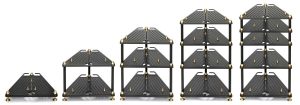
Live-Vibe Rhythm Platforms
I contacted my esteemed S.T. colleague, Mike Wright, who uses Live-Vibe Audio products in his system. Mike Wright pulls no punches. The conversation was straight and to the point. Mike told me in so many words, “The Rhythm Platforms are a no-brainer.” His opinion and feedback were very valuable to me at the time, especially coming from a trusted source.
Rhythm, as defined by the Encarta Dictionary, is the regular pattern of beats and emphasis in a piece of music; it is also a regular pattern of activity, such as the cycle of the seasons, night and day, or repeated function of the body.
A platform is defined as a raised-level area of flooring for speakers or performers, a position of authority or prominence that provides a good opportunity for doing something.
While reading the philosophy of the Rhythm Platforms, my spider senses activated immediately. What caught my interest was the fact that the company believes in vibration management as opposed to the elimination of vibration. This makes perfect sense to me, so I contacted Mr. Robert Maicks, the head of Product Innovation and Sound Engineering. Our conversation was very exhilarating and informative. Robert validated everything Mike Wright related to me in our earlier conversation. I decided to take the plunge and request a review sample for my amplifiers. We ultimately decided on a pair of top-of-the-line $2799 Rhythmic Platform RP-1, Audio Points, and Coupling Discs.
Arrival, unpacking, and assembly
When the UPS truck arrived less than a week later, I met the truck in front of my house; it took two drivers to place a size box in my garage; it was accompanied by a smaller box that housed the 2.0AP1D-CD4 audio points, APCD5 coupling discs, and assembly instructions. The first item I look for from a manufacturer is how much effort and time is put into their quality system; this includes build quality, packaging, website, etc. When I lifted the first box, it was evident how heavy it was (100 pounds); both RP-1 platforms were well packed for shipment, tightly protected with bubble wrap and packing paper. The items were double-boxed for extra protection.

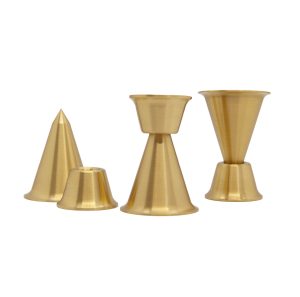 Both RP-1s arrived with zero damage. As I lifted each weighty platform and positioned it for assembly, I opened the second box with all the accessories to include assembly instructions. Each Audio Point was wrapped individually in heavy plastic, along with each coupling disc. The coupling discs are essential to the protection of your equipment as they protect from scratching the underside of your components. Each Audio Point and Coupling disc is manufactured with soft brass. Word of caution: if you like your skin, be careful when handling the Audio Points because they bite; I found out the hard way. Assembly is very straightforward, with no surprises; it’s best to have another person available to simplify things while assembling, although one person can still get it done.
Both RP-1s arrived with zero damage. As I lifted each weighty platform and positioned it for assembly, I opened the second box with all the accessories to include assembly instructions. Each Audio Point was wrapped individually in heavy plastic, along with each coupling disc. The coupling discs are essential to the protection of your equipment as they protect from scratching the underside of your components. Each Audio Point and Coupling disc is manufactured with soft brass. Word of caution: if you like your skin, be careful when handling the Audio Points because they bite; I found out the hard way. Assembly is very straightforward, with no surprises; it’s best to have another person available to simplify things while assembling, although one person can still get it done.
Ready for the first listening test
 Once both RP-1 Live Vibe Platforms were assembled and ready for the amplifiers, I sought a good friend’s help to lift the 110-pound Thrax Spartacus 300b amplifiers onto each platform. Before lifting the amplifier, I ensured each Audio Point was positioned correctly; this was carefully done because I did not want to lift those heavy amps a second time. Everything went as planned. The next task was to position both 320-pound Y.G. Acoustic Sonja speakers onto the Townshend 5 Speaker Platforms. After completing everything, it was time for a much-needed rest; the listening session would have to wait.
Once both RP-1 Live Vibe Platforms were assembled and ready for the amplifiers, I sought a good friend’s help to lift the 110-pound Thrax Spartacus 300b amplifiers onto each platform. Before lifting the amplifier, I ensured each Audio Point was positioned correctly; this was carefully done because I did not want to lift those heavy amps a second time. Everything went as planned. The next task was to position both 320-pound Y.G. Acoustic Sonja speakers onto the Townshend 5 Speaker Platforms. After completing everything, it was time for a much-needed rest; the listening session would have to wait.
After a few hours’ rest, I hooked up the amp and speaker cables, ensured nothing was out of place, and sat down for first impressions. Usually, nine times out of ten, it takes me a few days to discern what I am hearing; however, not in this case. All the improvements hit me all at once. The upside was immediately evident. I started with a more expansive sound stage, with more air, tighter bass, imaging, balance, and PRAT. Everything I listened to produced a next-level experience. From Herbie Hancock’s “Joni Letters” to Mark Isham’s “Blue Sun” to Gregory Porter’s “Liquid Spirit,” etc., they all projected a next-level experience, saturated with high-level sonics from high to low frequencies. I was now hearing what the amp, preamp, speakers, and sources were trying to reveal before adding the Live Vibe Audio RP-1 Platforms.
What’s Next?
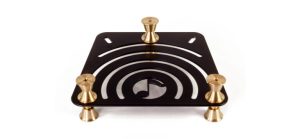
Ready for Phase 2
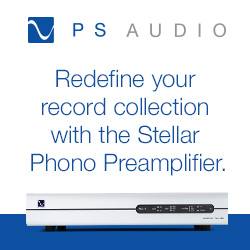 After experiencing the addition of the Live-Vibe Audio RP-1 over the next week, I had to know what the same effect would have on a pair of my REL G1 MKII Subwoofer. Subwoofers are very tough to integrate; the one feature I love about the REL G1 is it is very fast and comes with a remote that allows you to make on-the-fly adjustments. I had another conversation with Robert of Live-Vibe Audio; naturally, he’s not going to turn me away; however, what interested me was some of his comments about the REL subs and how he felt if done right, they are one of the best on the market. Eventually, he made some suggestions that seemed logical and prudent. I had him ship me a live-Vibe Audio RP-JR Advantage-4 pair with 2.0 Audio Points and Coupling Discs.
After experiencing the addition of the Live-Vibe Audio RP-1 over the next week, I had to know what the same effect would have on a pair of my REL G1 MKII Subwoofer. Subwoofers are very tough to integrate; the one feature I love about the REL G1 is it is very fast and comes with a remote that allows you to make on-the-fly adjustments. I had another conversation with Robert of Live-Vibe Audio; naturally, he’s not going to turn me away; however, what interested me was some of his comments about the REL subs and how he felt if done right, they are one of the best on the market. Eventually, he made some suggestions that seemed logical and prudent. I had him ship me a live-Vibe Audio RP-JR Advantage-4 pair with 2.0 Audio Points and Coupling Discs.
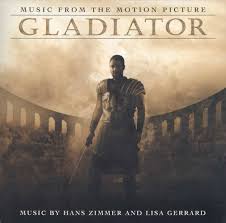 Aside from what I heard with the addition of the Live-Vibe Audio RP-1 Platforms, the addition of the RP-JR Advantage-4 fell in line without a hiccup. I have never heard my REL Subs perform so effortlessly. The integration to the Y.G. Acoustic Sonja was seamless; I am talking about it as if the Y.G. speakers were delivering sub-bass now. I was floored; however, the real test was when I played other music selections. I toned down my excitement meter for the time being and, throughout the day, sampled a plethora of musical selections. I would be remiss to say that everything I played did not require an adjustment or two; however, for the most part, it was a significant improvement over prior additions to the Live Vibe products. The bass and sub-bass work together with tight, punchy sonics with no boom or distortion. The bass is much more relaxed on heavy passages of music selections. I played Hans Zimmer’s “Gladiator” I never heard it sound so realistic/authentic. I listened to the selection of “The Battle.” It was so exhilarating that I was looking for my shield and sword. Talking about experiencing a sonic explosion, this selection delivers from top to bottom when played at a high volume. It is a must-have; however, I think it will be better experienced with a top-tier subwoofer placed on top of the RP-JR-Advantaged-4 from Live-Vibe Audio.
Aside from what I heard with the addition of the Live-Vibe Audio RP-1 Platforms, the addition of the RP-JR Advantage-4 fell in line without a hiccup. I have never heard my REL Subs perform so effortlessly. The integration to the Y.G. Acoustic Sonja was seamless; I am talking about it as if the Y.G. speakers were delivering sub-bass now. I was floored; however, the real test was when I played other music selections. I toned down my excitement meter for the time being and, throughout the day, sampled a plethora of musical selections. I would be remiss to say that everything I played did not require an adjustment or two; however, for the most part, it was a significant improvement over prior additions to the Live Vibe products. The bass and sub-bass work together with tight, punchy sonics with no boom or distortion. The bass is much more relaxed on heavy passages of music selections. I played Hans Zimmer’s “Gladiator” I never heard it sound so realistic/authentic. I listened to the selection of “The Battle.” It was so exhilarating that I was looking for my shield and sword. Talking about experiencing a sonic explosion, this selection delivers from top to bottom when played at a high volume. It is a must-have; however, I think it will be better experienced with a top-tier subwoofer placed on top of the RP-JR-Advantaged-4 from Live-Vibe Audio.
Finishing with Phase 3
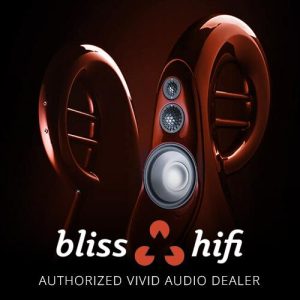 Phase 3 was not in the original plan; however, I had to take it further when I heard what the Live Vibe Audio platforms added to my amps and subs. I considered experimenting with 1.5 Audio Points and APCD5 Coupling Discs underneath the Y.G. Acoustic Sonja 2.2i Speakers. Since I now have both speakers placed on the Townshend 5 Platforms, I was first reluctant even to give this a try; however, as with most audiophiles, when we get an idea in our head, it will bug us until we at least try it, (good or bad). My job as a reviewer is to try the unthinkable occasionally. However, I have made it a career by reporting exactly what I hear; every piece of news is not always good.
Phase 3 was not in the original plan; however, I had to take it further when I heard what the Live Vibe Audio platforms added to my amps and subs. I considered experimenting with 1.5 Audio Points and APCD5 Coupling Discs underneath the Y.G. Acoustic Sonja 2.2i Speakers. Since I now have both speakers placed on the Townshend 5 Platforms, I was first reluctant even to give this a try; however, as with most audiophiles, when we get an idea in our head, it will bug us until we at least try it, (good or bad). My job as a reviewer is to try the unthinkable occasionally. However, I have made it a career by reporting exactly what I hear; every piece of news is not always good.
Robert took it upon himself to custom-build the thread size needed for the 1.5 Audio Points. Robert was very supportive of this phase of my journey. I can say that Robert is very involved in building great systems and will do whatever it takes to assist (if asked). I received another package from Live-Vibe Audio, and needless to say, the products were packaged with love. I had a friend come over, and we positioned both speakers to insert the Audio Points. Threading was perfect, and the placement of each coupling device was a cinch.
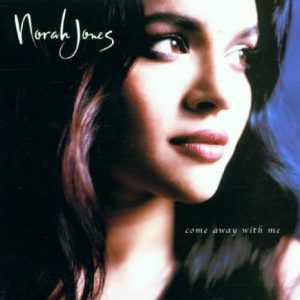 This is the most challenging part of the review because I am still in awe of what I heard that evening. The sheer reproduction of music was incredible. However, while installing the Audio Points, the left speaker must have moved 10 degrees or more, pointing right. When I first sat down, I was shocked at what I heard from Norah Jones’s voice. It was all over the sound stage, and the instruments were almost on the floor. My first inclination was these Audio Points were not performing as hoped. I need to remove them and get my sound back. However, after walking away and thinking about it, I came to my senses and re-toed the speakers over the next 30 minutes, and fortunately, the sound snapped back into place. It was fast with rhythmic accuracy and speed, while the bass was tighter than ever.
This is the most challenging part of the review because I am still in awe of what I heard that evening. The sheer reproduction of music was incredible. However, while installing the Audio Points, the left speaker must have moved 10 degrees or more, pointing right. When I first sat down, I was shocked at what I heard from Norah Jones’s voice. It was all over the sound stage, and the instruments were almost on the floor. My first inclination was these Audio Points were not performing as hoped. I need to remove them and get my sound back. However, after walking away and thinking about it, I came to my senses and re-toed the speakers over the next 30 minutes, and fortunately, the sound snapped back into place. It was fast with rhythmic accuracy and speed, while the bass was tighter than ever.
Conclusion:
We, as audiophiles, have a problem not knowing when to leave well enough alone. However, honestly, I am glad I am this way. I never would have experienced what the Live-Vibe Audio Products are capable of if I had stuck to the “leave well enough alone” concept. There are a plethora of products out there designed to improve our audio systems. The Live-Vibe Audio Products will take your system to the next level without any waiting time or burn-in requirements. “I HIGHLY RECOMMEND” giving them a try. And they stand by their Money Back Guarantee, a must in our hobby.


Specifications: Live-Vibe Audio, LLC
Prices Audio Points Sets used in Review
1.5 APID CD4 Set of 3 $349
RP-1 Rhythm Platform $2,799
RP J.R.- Advantage-4 Platform $1,149
RP-1 Specifications
Three (3) RP-FLR-PNT 3.5 Inch Large Rhythm Floor Points
Three (3) RP-TOP-CAP – Top caps for top shelf
Three (3) Audio Point model 2.5AP-1AINT – Shelf Audio Points
Three (3) AP-TB-HND-1A.5 Turning Bolts – For Audio Points tension
Three (3) APCD4 Coupling Discs – Inverted for equipment contact
Three (3) APCD5 Large Coupling Discs – For flooring, including all carpets
Shelf Thickness – .3125 Inches (5/16”)
Outside Width – 26 Inches, Depth – 24 Inches
Ship Weight – 50 Pounds, 2 Boxes
Specifications RP-JR-Advantage-4
Three (3) 2.0AP-1AINT
Three (3) 2.0AP-1A.5 Audio Points
Six (6) APCD4 Coupling Discs
One (1) Advantage Shelf
Overall Exacting Height = 4.80 Inches
Shelf Measurements 18.75″ W x 16.25″ D x 0.25” H
Contact:
Address: 100 Fallon Ave Wilmington, DE 19804 (Business Office)
Website: https://livevibeaudio.com
Email: sales@livevibe.com
Phone: 330-260-6769
Moreno’s Associated Equipment
Analog
Thrax Spartacus 300B Tube Amplifiers
Thrax Teres Hybrid Power Amplifiers
Thrax Libra 300B Tube Preamp
Zesto Audio Andros Deluxe II Phono Amp
Pro-Ject RPM 10 Carbon Turntable/ Van den Hul Stradivarius Cartridge
Otari MX5050BIII-2 Reel-Reel Tape Machine
Digital
Thrax Maximinus DAC
Esoteric K-01Xd CD/SACD Player
Network
Auralic Aires G2.1 Network Transport
Waversa EXT Reference Plus
Roon Neutrilik Plus
Sean Jacobs Power Supply
EtherRegen Network Switch
loudspeakers
Y.G. Acoustics Sonja 2.2i
REL G1 MKII Subwoofers (2)
Cables
Hemingway Sigma Speaker Cables
Hemingway Sigma, Beta, Alpha Power Cords
Albedo Metamorphosis Signature and MKII Monocrystal Interconnects (3 sets)
Albedo Gravity III Power Cords
Ansuz Digital DTC Supreme
Ansuz Audio Interconnect DTC
A.C. Conditioners
Puritan PSM156
Sound Application TT-7
Inakustic AC4500 Power Station
Accessories
Townshend Audio Seismic Platforms
StillPoints Stands S.S. Ultra 6’s
StillPoints Equipment Rack
Synergistic Research Black Box (2)
Room Tube Bass Traps
Ansuz DTC Power Box
QSA Quantum Science Audio Devices
Stereo Times Masthead
Publisher/Founder
Clement Perry
Editor
Dave Thomas
Senior Editors
Frank Alles, Mike Girardi, Russell Lichter, Terry London, Moreno Mitchell, Paul Szabady, Bill Wells, Mike Wright, and Stephen Yan,
Current Contributors
David Abramson, Tim Barrall, Dave Allison, Ron Cook, Lewis Dardick, John Hoffman, Dan Secula, Don Shaulis, Greg Simmons, Eric Teh, Greg Voth, Richard Willie, Ed Van Winkle, Rob Dockery, Richard Doran, and Daveed Turek
Site Management Clement Perry
Ad Designer: Martin Perry


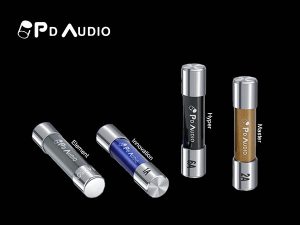



Be the first to comment on: Live-Vibe Audio RP-1 Vibration Management by Moreno Mitchell